EPID6660: Osteoporosis in the Ageing Population - A Public Health
VerifiedAdded on 2023/06/03
|20
|5384
|111
Report
AI Summary
This report defines osteoporosis, detailing its prevalence, causes, and impact on ageing populations, especially women post-menopause. It addresses risk factors, including hormonal changes and lifestyle elements, and explores preventive measures such as exercise, calcium intake, and vitamin D supplementation. The report also references research on osteoporosis prevention, like the National Bone Health Campaign, which emphasizes early education. It highlights common fracture sites like wrists, hips, and spine, and discusses the impact of these fractures on quality of life. The report concludes with practical approaches to prevention, including weight-bearing exercises, calcium-rich diets, supplements, and vitamin D intake, underscoring the importance of proactive bone health management.
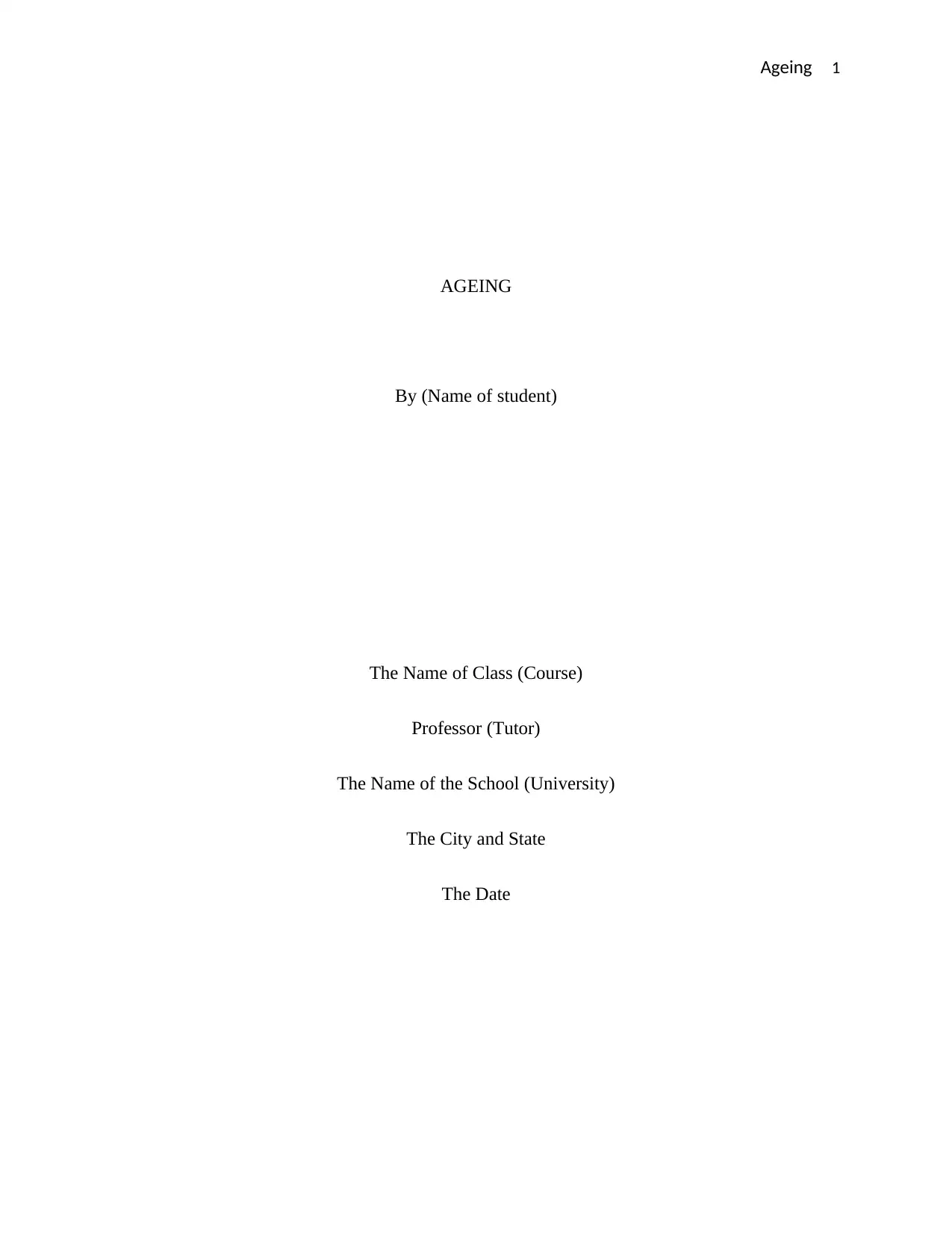
Ageing 1
AGEING
By (Name of student)
The Name of Class (Course)
Professor (Tutor)
The Name of the School (University)
The City and State
The Date
AGEING
By (Name of student)
The Name of Class (Course)
Professor (Tutor)
The Name of the School (University)
The City and State
The Date
Paraphrase This Document
Need a fresh take? Get an instant paraphrase of this document with our AI Paraphraser
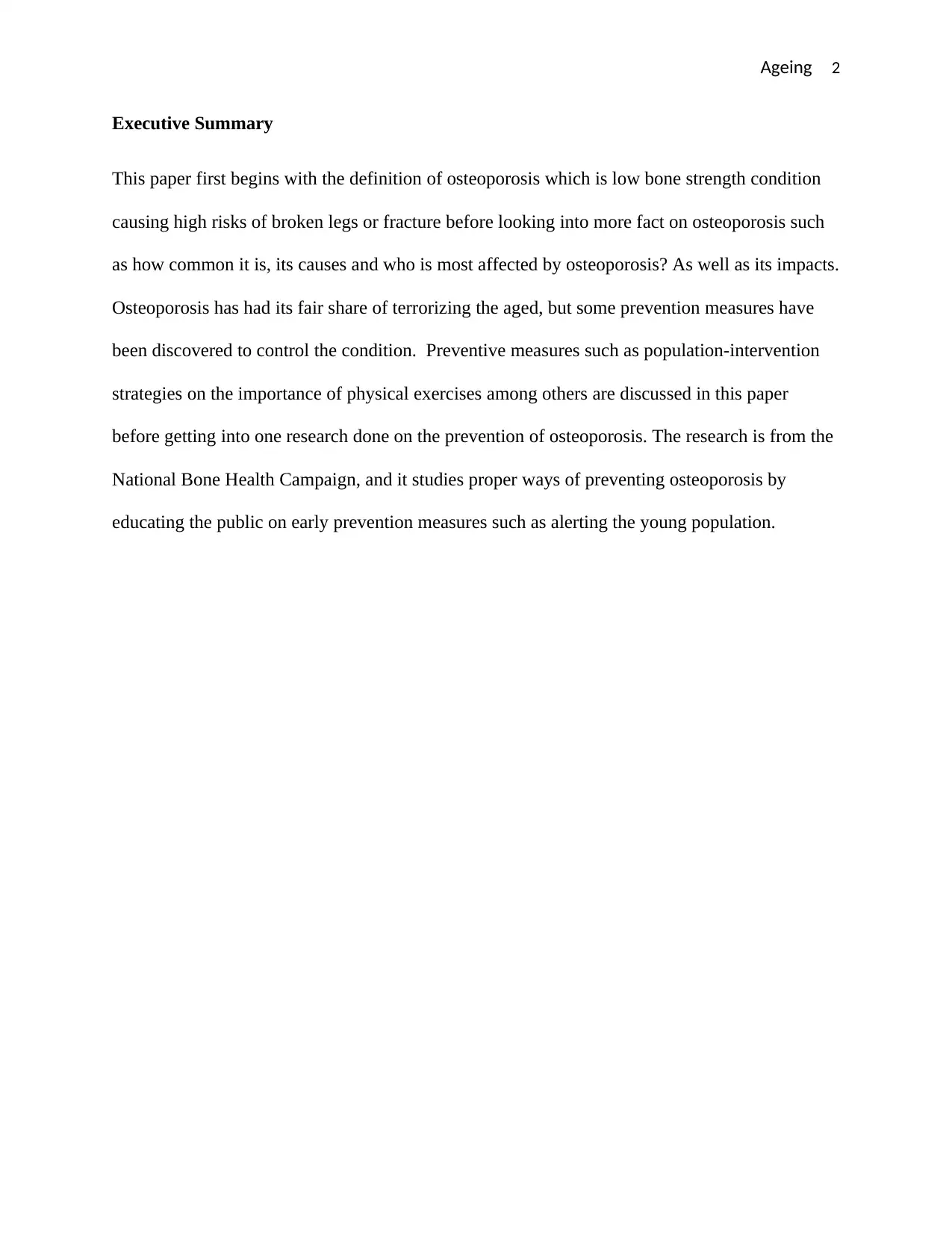
Ageing 2
Executive Summary
This paper first begins with the definition of osteoporosis which is low bone strength condition
causing high risks of broken legs or fracture before looking into more fact on osteoporosis such
as how common it is, its causes and who is most affected by osteoporosis? As well as its impacts.
Osteoporosis has had its fair share of terrorizing the aged, but some prevention measures have
been discovered to control the condition. Preventive measures such as population-intervention
strategies on the importance of physical exercises among others are discussed in this paper
before getting into one research done on the prevention of osteoporosis. The research is from the
National Bone Health Campaign, and it studies proper ways of preventing osteoporosis by
educating the public on early prevention measures such as alerting the young population.
Executive Summary
This paper first begins with the definition of osteoporosis which is low bone strength condition
causing high risks of broken legs or fracture before looking into more fact on osteoporosis such
as how common it is, its causes and who is most affected by osteoporosis? As well as its impacts.
Osteoporosis has had its fair share of terrorizing the aged, but some prevention measures have
been discovered to control the condition. Preventive measures such as population-intervention
strategies on the importance of physical exercises among others are discussed in this paper
before getting into one research done on the prevention of osteoporosis. The research is from the
National Bone Health Campaign, and it studies proper ways of preventing osteoporosis by
educating the public on early prevention measures such as alerting the young population.
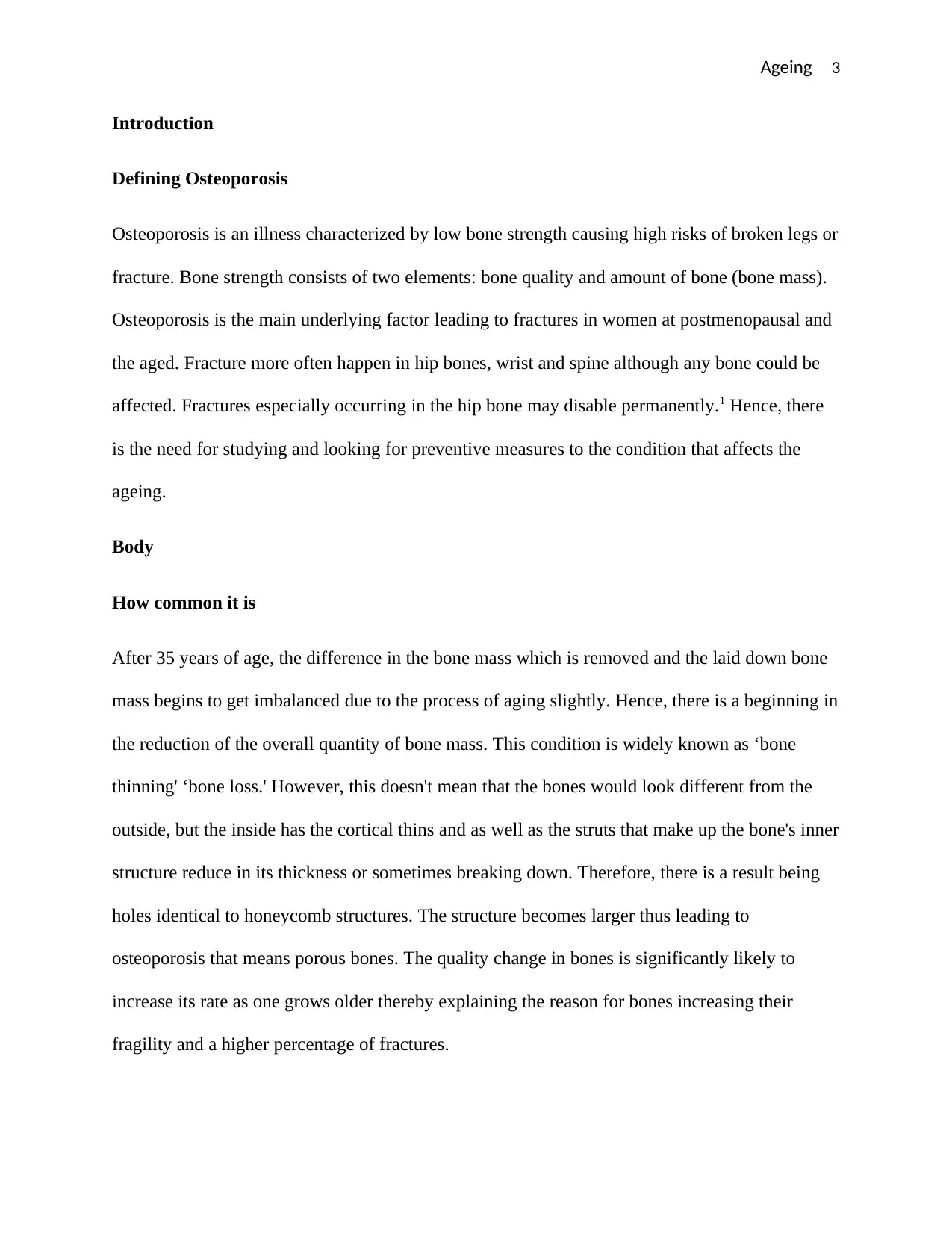
Ageing 3
Introduction
Defining Osteoporosis
Osteoporosis is an illness characterized by low bone strength causing high risks of broken legs or
fracture. Bone strength consists of two elements: bone quality and amount of bone (bone mass).
Osteoporosis is the main underlying factor leading to fractures in women at postmenopausal and
the aged. Fracture more often happen in hip bones, wrist and spine although any bone could be
affected. Fractures especially occurring in the hip bone may disable permanently.1 Hence, there
is the need for studying and looking for preventive measures to the condition that affects the
ageing.
Body
How common it is
After 35 years of age, the difference in the bone mass which is removed and the laid down bone
mass begins to get imbalanced due to the process of aging slightly. Hence, there is a beginning in
the reduction of the overall quantity of bone mass. This condition is widely known as ‘bone
thinning' ‘bone loss.' However, this doesn't mean that the bones would look different from the
outside, but the inside has the cortical thins and as well as the struts that make up the bone's inner
structure reduce in its thickness or sometimes breaking down. Therefore, there is a result being
holes identical to honeycomb structures. The structure becomes larger thus leading to
osteoporosis that means porous bones. The quality change in bones is significantly likely to
increase its rate as one grows older thereby explaining the reason for bones increasing their
fragility and a higher percentage of fractures.
Introduction
Defining Osteoporosis
Osteoporosis is an illness characterized by low bone strength causing high risks of broken legs or
fracture. Bone strength consists of two elements: bone quality and amount of bone (bone mass).
Osteoporosis is the main underlying factor leading to fractures in women at postmenopausal and
the aged. Fracture more often happen in hip bones, wrist and spine although any bone could be
affected. Fractures especially occurring in the hip bone may disable permanently.1 Hence, there
is the need for studying and looking for preventive measures to the condition that affects the
ageing.
Body
How common it is
After 35 years of age, the difference in the bone mass which is removed and the laid down bone
mass begins to get imbalanced due to the process of aging slightly. Hence, there is a beginning in
the reduction of the overall quantity of bone mass. This condition is widely known as ‘bone
thinning' ‘bone loss.' However, this doesn't mean that the bones would look different from the
outside, but the inside has the cortical thins and as well as the struts that make up the bone's inner
structure reduce in its thickness or sometimes breaking down. Therefore, there is a result being
holes identical to honeycomb structures. The structure becomes larger thus leading to
osteoporosis that means porous bones. The quality change in bones is significantly likely to
increase its rate as one grows older thereby explaining the reason for bones increasing their
fragility and a higher percentage of fractures.
⊘ This is a preview!⊘
Do you want full access?
Subscribe today to unlock all pages.

Trusted by 1+ million students worldwide
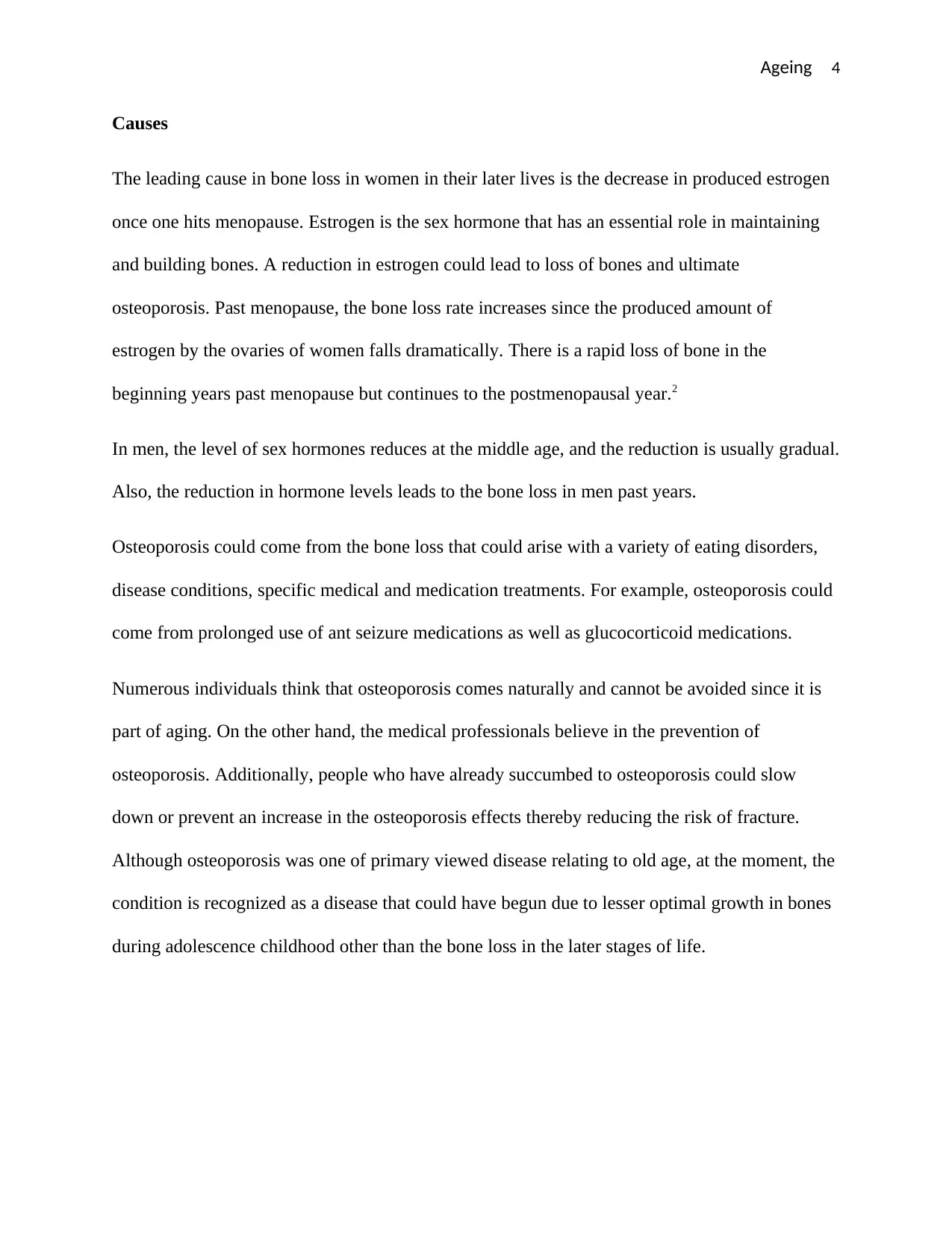
Ageing 4
Causes
The leading cause in bone loss in women in their later lives is the decrease in produced estrogen
once one hits menopause. Estrogen is the sex hormone that has an essential role in maintaining
and building bones. A reduction in estrogen could lead to loss of bones and ultimate
osteoporosis. Past menopause, the bone loss rate increases since the produced amount of
estrogen by the ovaries of women falls dramatically. There is a rapid loss of bone in the
beginning years past menopause but continues to the postmenopausal year.2
In men, the level of sex hormones reduces at the middle age, and the reduction is usually gradual.
Also, the reduction in hormone levels leads to the bone loss in men past years.
Osteoporosis could come from the bone loss that could arise with a variety of eating disorders,
disease conditions, specific medical and medication treatments. For example, osteoporosis could
come from prolonged use of ant seizure medications as well as glucocorticoid medications.
Numerous individuals think that osteoporosis comes naturally and cannot be avoided since it is
part of aging. On the other hand, the medical professionals believe in the prevention of
osteoporosis. Additionally, people who have already succumbed to osteoporosis could slow
down or prevent an increase in the osteoporosis effects thereby reducing the risk of fracture.
Although osteoporosis was one of primary viewed disease relating to old age, at the moment, the
condition is recognized as a disease that could have begun due to lesser optimal growth in bones
during adolescence childhood other than the bone loss in the later stages of life.
Causes
The leading cause in bone loss in women in their later lives is the decrease in produced estrogen
once one hits menopause. Estrogen is the sex hormone that has an essential role in maintaining
and building bones. A reduction in estrogen could lead to loss of bones and ultimate
osteoporosis. Past menopause, the bone loss rate increases since the produced amount of
estrogen by the ovaries of women falls dramatically. There is a rapid loss of bone in the
beginning years past menopause but continues to the postmenopausal year.2
In men, the level of sex hormones reduces at the middle age, and the reduction is usually gradual.
Also, the reduction in hormone levels leads to the bone loss in men past years.
Osteoporosis could come from the bone loss that could arise with a variety of eating disorders,
disease conditions, specific medical and medication treatments. For example, osteoporosis could
come from prolonged use of ant seizure medications as well as glucocorticoid medications.
Numerous individuals think that osteoporosis comes naturally and cannot be avoided since it is
part of aging. On the other hand, the medical professionals believe in the prevention of
osteoporosis. Additionally, people who have already succumbed to osteoporosis could slow
down or prevent an increase in the osteoporosis effects thereby reducing the risk of fracture.
Although osteoporosis was one of primary viewed disease relating to old age, at the moment, the
condition is recognized as a disease that could have begun due to lesser optimal growth in bones
during adolescence childhood other than the bone loss in the later stages of life.
Paraphrase This Document
Need a fresh take? Get an instant paraphrase of this document with our AI Paraphraser
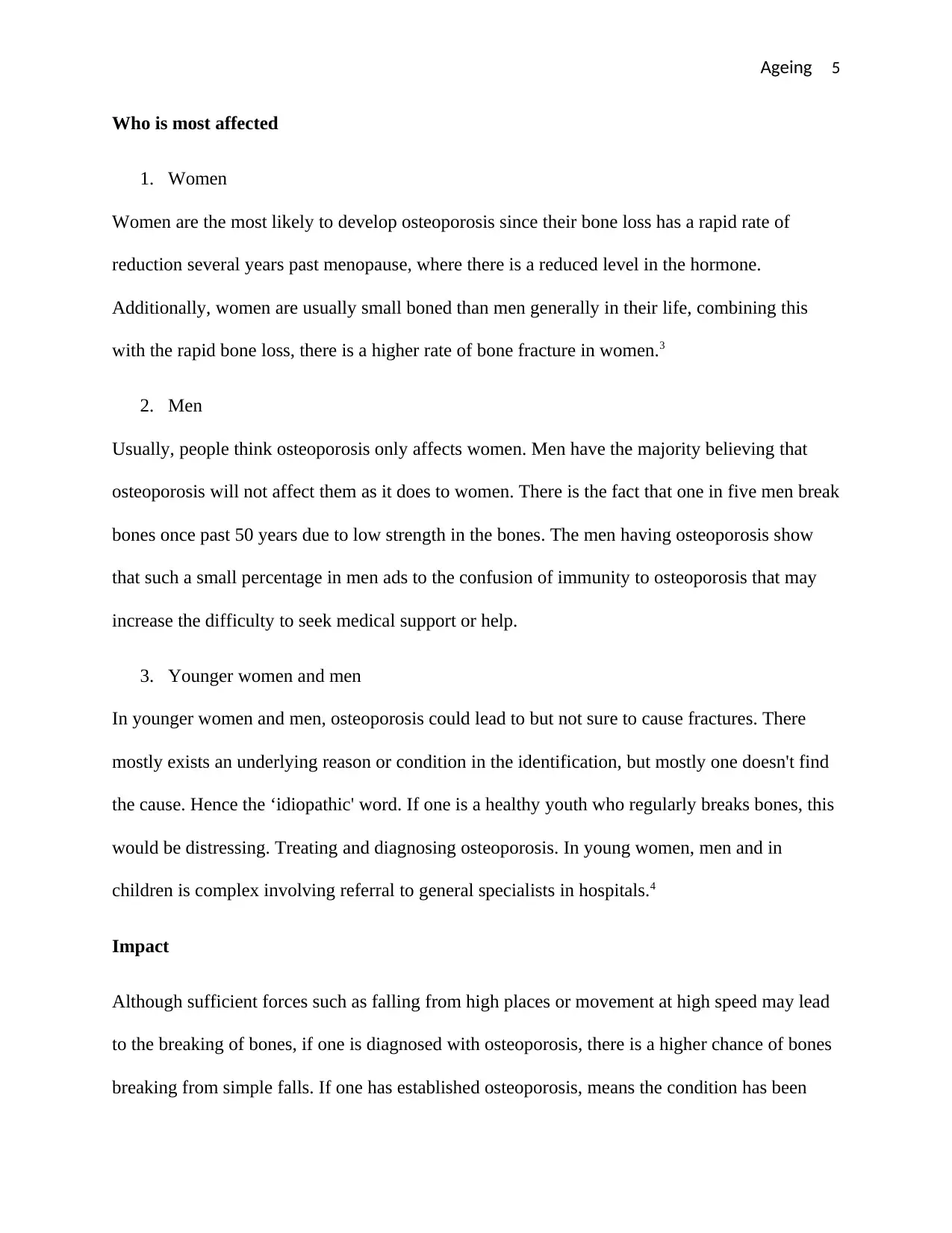
Ageing 5
Who is most affected
1. Women
Women are the most likely to develop osteoporosis since their bone loss has a rapid rate of
reduction several years past menopause, where there is a reduced level in the hormone.
Additionally, women are usually small boned than men generally in their life, combining this
with the rapid bone loss, there is a higher rate of bone fracture in women.3
2. Men
Usually, people think osteoporosis only affects women. Men have the majority believing that
osteoporosis will not affect them as it does to women. There is the fact that one in five men break
bones once past 50 years due to low strength in the bones. The men having osteoporosis show
that such a small percentage in men ads to the confusion of immunity to osteoporosis that may
increase the difficulty to seek medical support or help.
3. Younger women and men
In younger women and men, osteoporosis could lead to but not sure to cause fractures. There
mostly exists an underlying reason or condition in the identification, but mostly one doesn't find
the cause. Hence the ‘idiopathic' word. If one is a healthy youth who regularly breaks bones, this
would be distressing. Treating and diagnosing osteoporosis. In young women, men and in
children is complex involving referral to general specialists in hospitals.4
Impact
Although sufficient forces such as falling from high places or movement at high speed may lead
to the breaking of bones, if one is diagnosed with osteoporosis, there is a higher chance of bones
breaking from simple falls. If one has established osteoporosis, means the condition has been
Who is most affected
1. Women
Women are the most likely to develop osteoporosis since their bone loss has a rapid rate of
reduction several years past menopause, where there is a reduced level in the hormone.
Additionally, women are usually small boned than men generally in their life, combining this
with the rapid bone loss, there is a higher rate of bone fracture in women.3
2. Men
Usually, people think osteoporosis only affects women. Men have the majority believing that
osteoporosis will not affect them as it does to women. There is the fact that one in five men break
bones once past 50 years due to low strength in the bones. The men having osteoporosis show
that such a small percentage in men ads to the confusion of immunity to osteoporosis that may
increase the difficulty to seek medical support or help.
3. Younger women and men
In younger women and men, osteoporosis could lead to but not sure to cause fractures. There
mostly exists an underlying reason or condition in the identification, but mostly one doesn't find
the cause. Hence the ‘idiopathic' word. If one is a healthy youth who regularly breaks bones, this
would be distressing. Treating and diagnosing osteoporosis. In young women, men and in
children is complex involving referral to general specialists in hospitals.4
Impact
Although sufficient forces such as falling from high places or movement at high speed may lead
to the breaking of bones, if one is diagnosed with osteoporosis, there is a higher chance of bones
breaking from simple falls. If one has established osteoporosis, means the condition has been
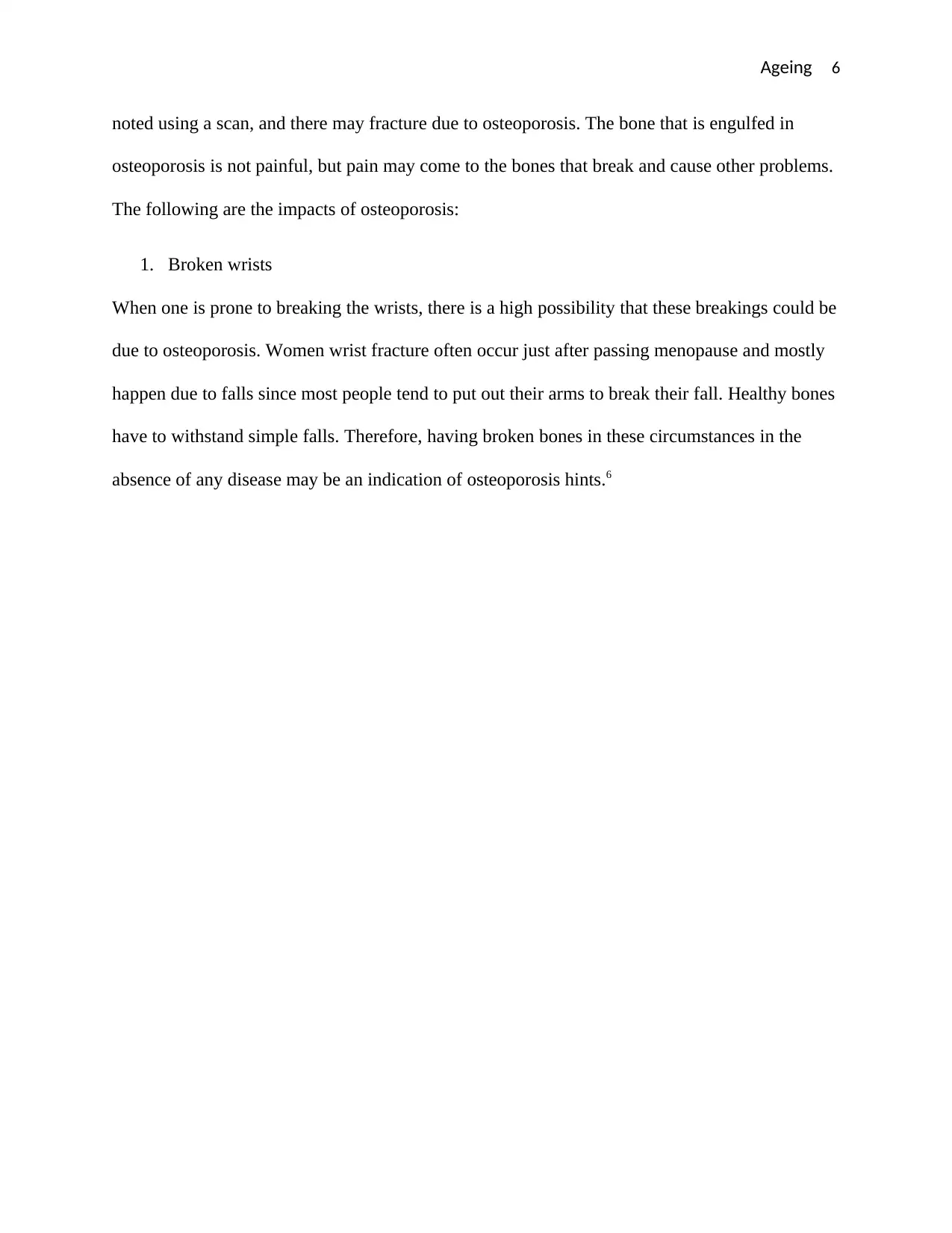
Ageing 6
noted using a scan, and there may fracture due to osteoporosis. The bone that is engulfed in
osteoporosis is not painful, but pain may come to the bones that break and cause other problems.
The following are the impacts of osteoporosis:
1. Broken wrists
When one is prone to breaking the wrists, there is a high possibility that these breakings could be
due to osteoporosis. Women wrist fracture often occur just after passing menopause and mostly
happen due to falls since most people tend to put out their arms to break their fall. Healthy bones
have to withstand simple falls. Therefore, having broken bones in these circumstances in the
absence of any disease may be an indication of osteoporosis hints.6
noted using a scan, and there may fracture due to osteoporosis. The bone that is engulfed in
osteoporosis is not painful, but pain may come to the bones that break and cause other problems.
The following are the impacts of osteoporosis:
1. Broken wrists
When one is prone to breaking the wrists, there is a high possibility that these breakings could be
due to osteoporosis. Women wrist fracture often occur just after passing menopause and mostly
happen due to falls since most people tend to put out their arms to break their fall. Healthy bones
have to withstand simple falls. Therefore, having broken bones in these circumstances in the
absence of any disease may be an indication of osteoporosis hints.6
⊘ This is a preview!⊘
Do you want full access?
Subscribe today to unlock all pages.

Trusted by 1+ million students worldwide
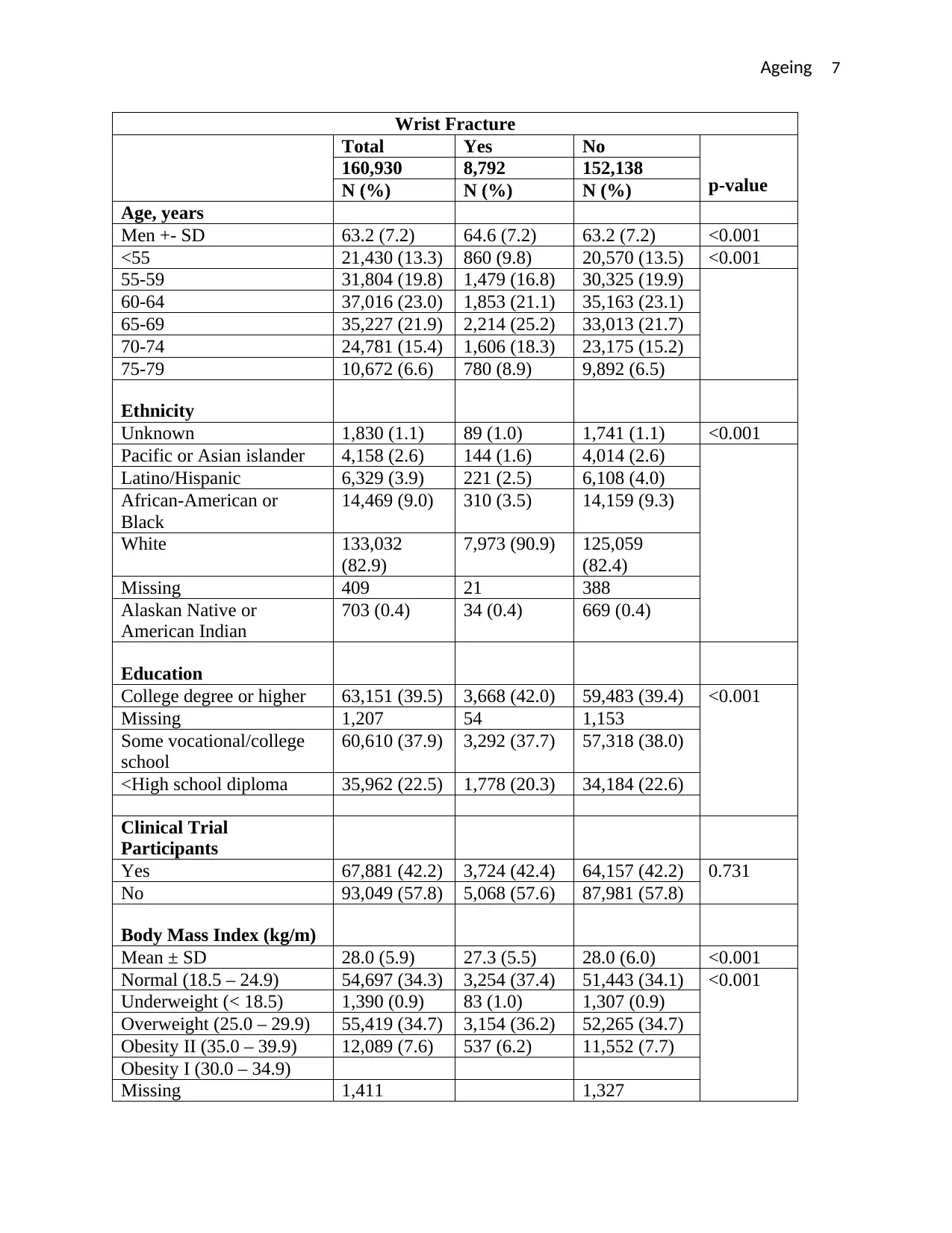
Ageing 7
Wrist Fracture
Total Yes No
p-value
160,930 8,792 152,138
N (%) N (%) N (%)
Age, years
Men +- SD 63.2 (7.2) 64.6 (7.2) 63.2 (7.2) <0.001
<55 21,430 (13.3) 860 (9.8) 20,570 (13.5) <0.001
55-59 31,804 (19.8) 1,479 (16.8) 30,325 (19.9)
60-64 37,016 (23.0) 1,853 (21.1) 35,163 (23.1)
65-69 35,227 (21.9) 2,214 (25.2) 33,013 (21.7)
70-74 24,781 (15.4) 1,606 (18.3) 23,175 (15.2)
75-79 10,672 (6.6) 780 (8.9) 9,892 (6.5)
Ethnicity
Unknown 1,830 (1.1) 89 (1.0) 1,741 (1.1) <0.001
Pacific or Asian islander 4,158 (2.6) 144 (1.6) 4,014 (2.6)
Latino/Hispanic 6,329 (3.9) 221 (2.5) 6,108 (4.0)
African-American or
Black
14,469 (9.0) 310 (3.5) 14,159 (9.3)
White 133,032
(82.9)
7,973 (90.9) 125,059
(82.4)
Missing 409 21 388
Alaskan Native or
American Indian
703 (0.4) 34 (0.4) 669 (0.4)
Education
College degree or higher 63,151 (39.5) 3,668 (42.0) 59,483 (39.4) <0.001
Missing 1,207 54 1,153
Some vocational/college
school
60,610 (37.9) 3,292 (37.7) 57,318 (38.0)
<High school diploma 35,962 (22.5) 1,778 (20.3) 34,184 (22.6)
Clinical Trial
Participants
Yes 67,881 (42.2) 3,724 (42.4) 64,157 (42.2) 0.731
No 93,049 (57.8) 5,068 (57.6) 87,981 (57.8)
Body Mass Index (kg/m)
Mean ± SD 28.0 (5.9) 27.3 (5.5) 28.0 (6.0) <0.001
Normal (18.5 – 24.9) 54,697 (34.3) 3,254 (37.4) 51,443 (34.1) <0.001
Underweight (< 18.5) 1,390 (0.9) 83 (1.0) 1,307 (0.9)
Overweight (25.0 – 29.9) 55,419 (34.7) 3,154 (36.2) 52,265 (34.7)
Obesity II (35.0 – 39.9) 12,089 (7.6) 537 (6.2) 11,552 (7.7)
Obesity I (30.0 – 34.9)
Missing 1,411 1,327
Wrist Fracture
Total Yes No
p-value
160,930 8,792 152,138
N (%) N (%) N (%)
Age, years
Men +- SD 63.2 (7.2) 64.6 (7.2) 63.2 (7.2) <0.001
<55 21,430 (13.3) 860 (9.8) 20,570 (13.5) <0.001
55-59 31,804 (19.8) 1,479 (16.8) 30,325 (19.9)
60-64 37,016 (23.0) 1,853 (21.1) 35,163 (23.1)
65-69 35,227 (21.9) 2,214 (25.2) 33,013 (21.7)
70-74 24,781 (15.4) 1,606 (18.3) 23,175 (15.2)
75-79 10,672 (6.6) 780 (8.9) 9,892 (6.5)
Ethnicity
Unknown 1,830 (1.1) 89 (1.0) 1,741 (1.1) <0.001
Pacific or Asian islander 4,158 (2.6) 144 (1.6) 4,014 (2.6)
Latino/Hispanic 6,329 (3.9) 221 (2.5) 6,108 (4.0)
African-American or
Black
14,469 (9.0) 310 (3.5) 14,159 (9.3)
White 133,032
(82.9)
7,973 (90.9) 125,059
(82.4)
Missing 409 21 388
Alaskan Native or
American Indian
703 (0.4) 34 (0.4) 669 (0.4)
Education
College degree or higher 63,151 (39.5) 3,668 (42.0) 59,483 (39.4) <0.001
Missing 1,207 54 1,153
Some vocational/college
school
60,610 (37.9) 3,292 (37.7) 57,318 (38.0)
<High school diploma 35,962 (22.5) 1,778 (20.3) 34,184 (22.6)
Clinical Trial
Participants
Yes 67,881 (42.2) 3,724 (42.4) 64,157 (42.2) 0.731
No 93,049 (57.8) 5,068 (57.6) 87,981 (57.8)
Body Mass Index (kg/m)
Mean ± SD 28.0 (5.9) 27.3 (5.5) 28.0 (6.0) <0.001
Normal (18.5 – 24.9) 54,697 (34.3) 3,254 (37.4) 51,443 (34.1) <0.001
Underweight (< 18.5) 1,390 (0.9) 83 (1.0) 1,307 (0.9)
Overweight (25.0 – 29.9) 55,419 (34.7) 3,154 (36.2) 52,265 (34.7)
Obesity II (35.0 – 39.9) 12,089 (7.6) 537 (6.2) 11,552 (7.7)
Obesity I (30.0 – 34.9)
Missing 1,411 1,327
Paraphrase This Document
Need a fresh take? Get an instant paraphrase of this document with our AI Paraphraser
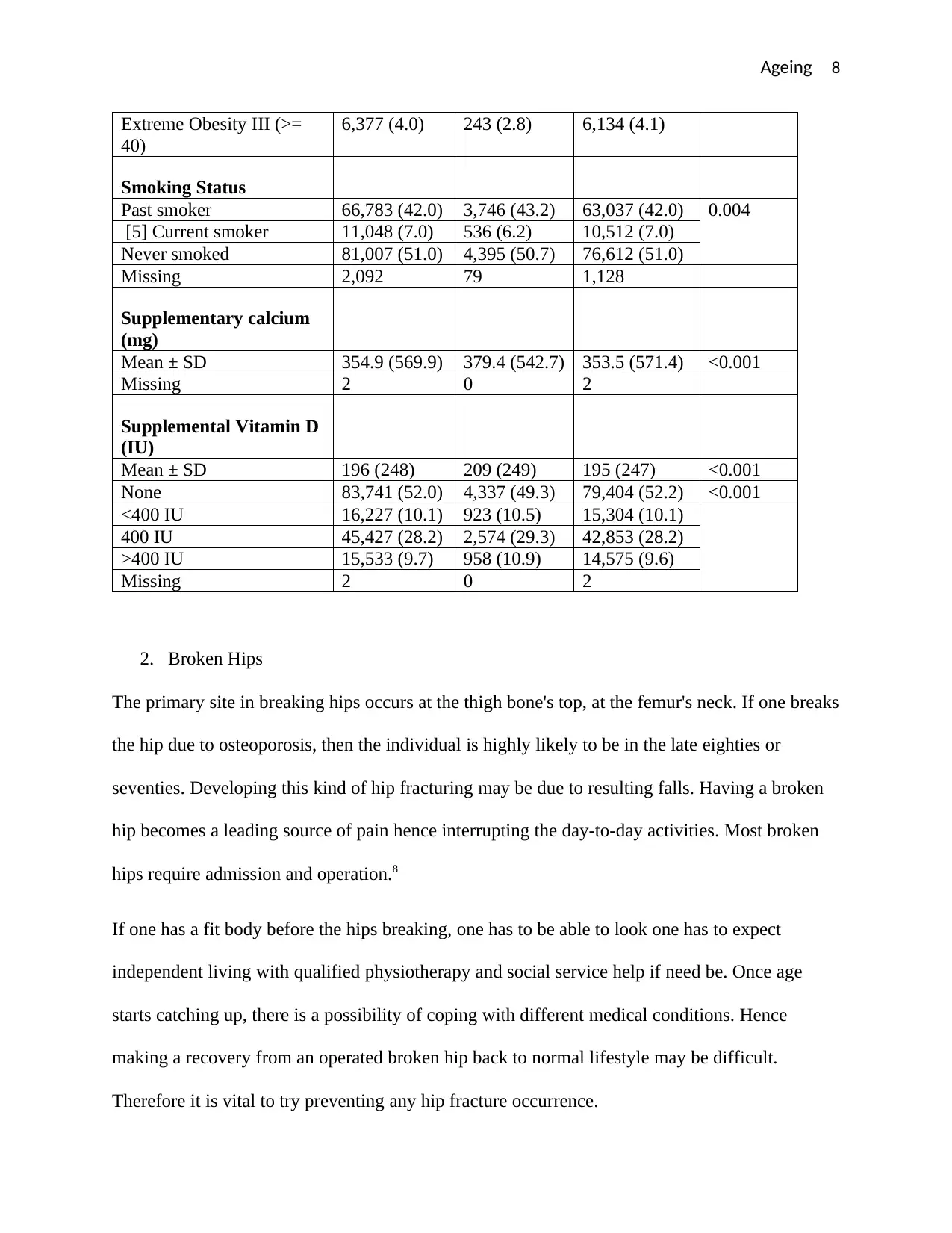
Ageing 8
Extreme Obesity III (>=
40)
6,377 (4.0) 243 (2.8) 6,134 (4.1)
Smoking Status
Past smoker 66,783 (42.0) 3,746 (43.2) 63,037 (42.0) 0.004
[5] Current smoker 11,048 (7.0) 536 (6.2) 10,512 (7.0)
Never smoked 81,007 (51.0) 4,395 (50.7) 76,612 (51.0)
Missing 2,092 79 1,128
Supplementary calcium
(mg)
Mean ± SD 354.9 (569.9) 379.4 (542.7) 353.5 (571.4) <0.001
Missing 2 0 2
Supplemental Vitamin D
(IU)
Mean ± SD 196 (248) 209 (249) 195 (247) <0.001
None 83,741 (52.0) 4,337 (49.3) 79,404 (52.2) <0.001
<400 IU 16,227 (10.1) 923 (10.5) 15,304 (10.1)
400 IU 45,427 (28.2) 2,574 (29.3) 42,853 (28.2)
>400 IU 15,533 (9.7) 958 (10.9) 14,575 (9.6)
Missing 2 0 2
2. Broken Hips
The primary site in breaking hips occurs at the thigh bone's top, at the femur's neck. If one breaks
the hip due to osteoporosis, then the individual is highly likely to be in the late eighties or
seventies. Developing this kind of hip fracturing may be due to resulting falls. Having a broken
hip becomes a leading source of pain hence interrupting the day-to-day activities. Most broken
hips require admission and operation.8
If one has a fit body before the hips breaking, one has to be able to look one has to expect
independent living with qualified physiotherapy and social service help if need be. Once age
starts catching up, there is a possibility of coping with different medical conditions. Hence
making a recovery from an operated broken hip back to normal lifestyle may be difficult.
Therefore it is vital to try preventing any hip fracture occurrence.
Extreme Obesity III (>=
40)
6,377 (4.0) 243 (2.8) 6,134 (4.1)
Smoking Status
Past smoker 66,783 (42.0) 3,746 (43.2) 63,037 (42.0) 0.004
[5] Current smoker 11,048 (7.0) 536 (6.2) 10,512 (7.0)
Never smoked 81,007 (51.0) 4,395 (50.7) 76,612 (51.0)
Missing 2,092 79 1,128
Supplementary calcium
(mg)
Mean ± SD 354.9 (569.9) 379.4 (542.7) 353.5 (571.4) <0.001
Missing 2 0 2
Supplemental Vitamin D
(IU)
Mean ± SD 196 (248) 209 (249) 195 (247) <0.001
None 83,741 (52.0) 4,337 (49.3) 79,404 (52.2) <0.001
<400 IU 16,227 (10.1) 923 (10.5) 15,304 (10.1)
400 IU 45,427 (28.2) 2,574 (29.3) 42,853 (28.2)
>400 IU 15,533 (9.7) 958 (10.9) 14,575 (9.6)
Missing 2 0 2
2. Broken Hips
The primary site in breaking hips occurs at the thigh bone's top, at the femur's neck. If one breaks
the hip due to osteoporosis, then the individual is highly likely to be in the late eighties or
seventies. Developing this kind of hip fracturing may be due to resulting falls. Having a broken
hip becomes a leading source of pain hence interrupting the day-to-day activities. Most broken
hips require admission and operation.8
If one has a fit body before the hips breaking, one has to be able to look one has to expect
independent living with qualified physiotherapy and social service help if need be. Once age
starts catching up, there is a possibility of coping with different medical conditions. Hence
making a recovery from an operated broken hip back to normal lifestyle may be difficult.
Therefore it is vital to try preventing any hip fracture occurrence.
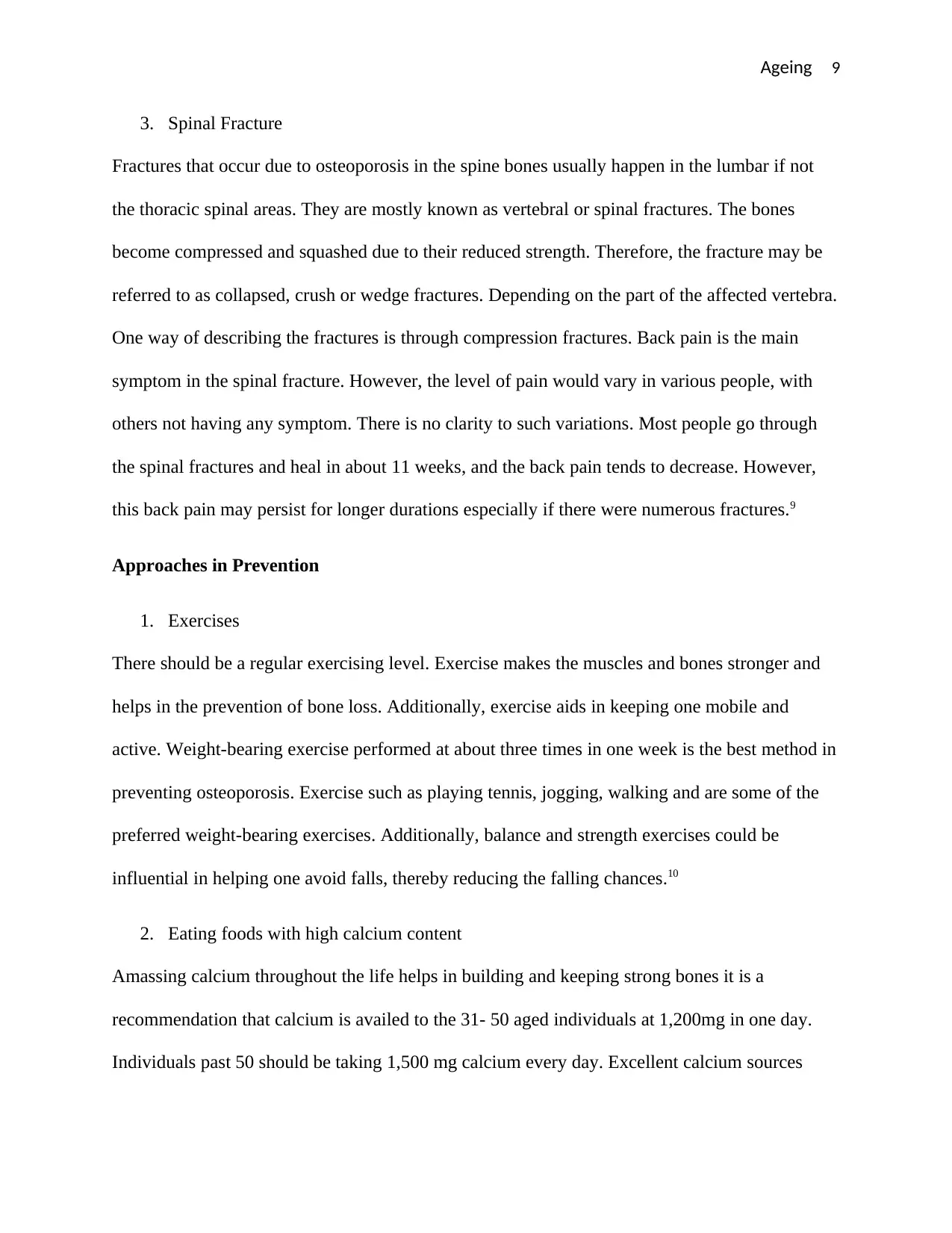
Ageing 9
3. Spinal Fracture
Fractures that occur due to osteoporosis in the spine bones usually happen in the lumbar if not
the thoracic spinal areas. They are mostly known as vertebral or spinal fractures. The bones
become compressed and squashed due to their reduced strength. Therefore, the fracture may be
referred to as collapsed, crush or wedge fractures. Depending on the part of the affected vertebra.
One way of describing the fractures is through compression fractures. Back pain is the main
symptom in the spinal fracture. However, the level of pain would vary in various people, with
others not having any symptom. There is no clarity to such variations. Most people go through
the spinal fractures and heal in about 11 weeks, and the back pain tends to decrease. However,
this back pain may persist for longer durations especially if there were numerous fractures.9
Approaches in Prevention
1. Exercises
There should be a regular exercising level. Exercise makes the muscles and bones stronger and
helps in the prevention of bone loss. Additionally, exercise aids in keeping one mobile and
active. Weight-bearing exercise performed at about three times in one week is the best method in
preventing osteoporosis. Exercise such as playing tennis, jogging, walking and are some of the
preferred weight-bearing exercises. Additionally, balance and strength exercises could be
influential in helping one avoid falls, thereby reducing the falling chances.10
2. Eating foods with high calcium content
Amassing calcium throughout the life helps in building and keeping strong bones it is a
recommendation that calcium is availed to the 31- 50 aged individuals at 1,200mg in one day.
Individuals past 50 should be taking 1,500 mg calcium every day. Excellent calcium sources
3. Spinal Fracture
Fractures that occur due to osteoporosis in the spine bones usually happen in the lumbar if not
the thoracic spinal areas. They are mostly known as vertebral or spinal fractures. The bones
become compressed and squashed due to their reduced strength. Therefore, the fracture may be
referred to as collapsed, crush or wedge fractures. Depending on the part of the affected vertebra.
One way of describing the fractures is through compression fractures. Back pain is the main
symptom in the spinal fracture. However, the level of pain would vary in various people, with
others not having any symptom. There is no clarity to such variations. Most people go through
the spinal fractures and heal in about 11 weeks, and the back pain tends to decrease. However,
this back pain may persist for longer durations especially if there were numerous fractures.9
Approaches in Prevention
1. Exercises
There should be a regular exercising level. Exercise makes the muscles and bones stronger and
helps in the prevention of bone loss. Additionally, exercise aids in keeping one mobile and
active. Weight-bearing exercise performed at about three times in one week is the best method in
preventing osteoporosis. Exercise such as playing tennis, jogging, walking and are some of the
preferred weight-bearing exercises. Additionally, balance and strength exercises could be
influential in helping one avoid falls, thereby reducing the falling chances.10
2. Eating foods with high calcium content
Amassing calcium throughout the life helps in building and keeping strong bones it is a
recommendation that calcium is availed to the 31- 50 aged individuals at 1,200mg in one day.
Individuals past 50 should be taking 1,500 mg calcium every day. Excellent calcium sources
⊘ This is a preview!⊘
Do you want full access?
Subscribe today to unlock all pages.

Trusted by 1+ million students worldwide
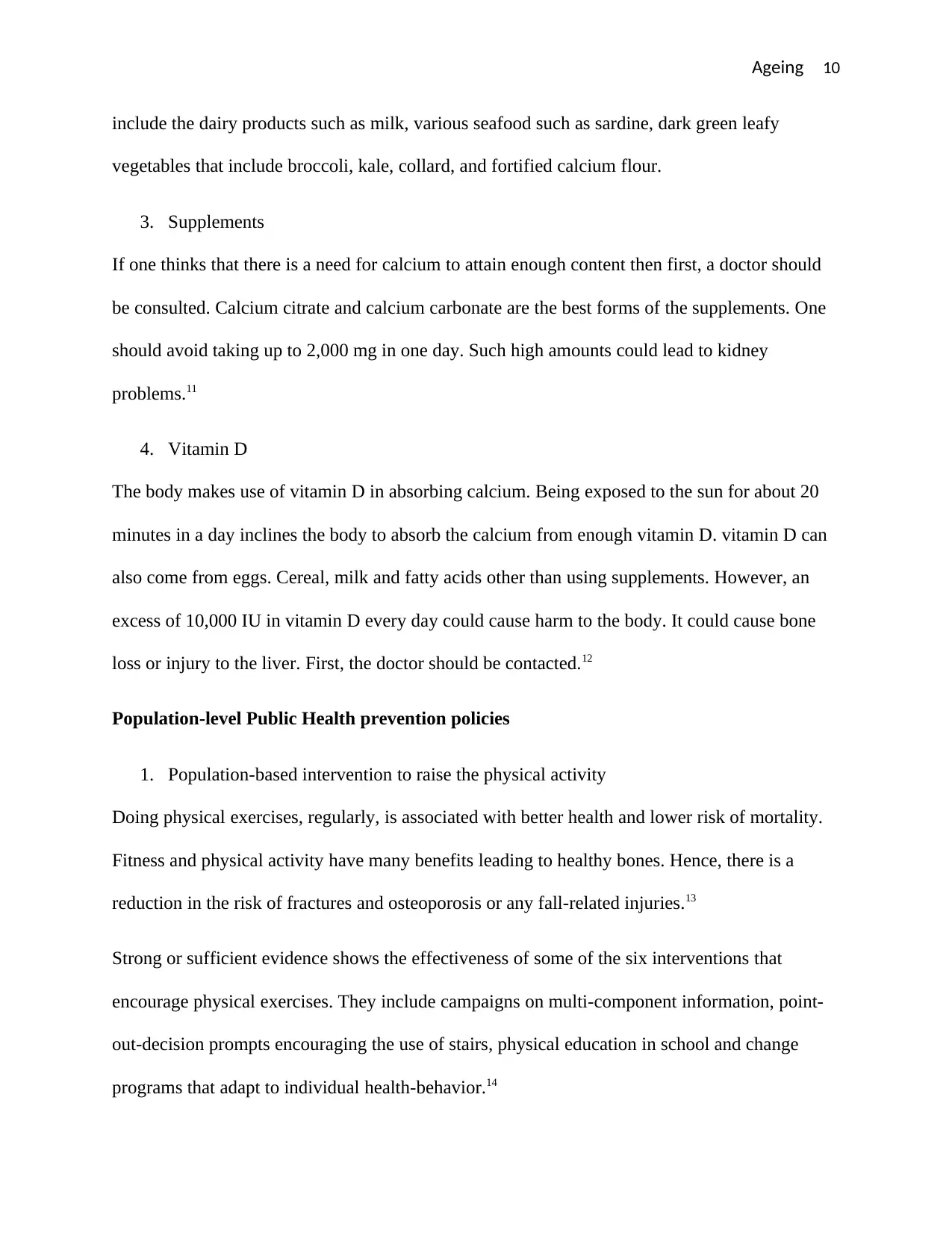
Ageing 10
include the dairy products such as milk, various seafood such as sardine, dark green leafy
vegetables that include broccoli, kale, collard, and fortified calcium flour.
3. Supplements
If one thinks that there is a need for calcium to attain enough content then first, a doctor should
be consulted. Calcium citrate and calcium carbonate are the best forms of the supplements. One
should avoid taking up to 2,000 mg in one day. Such high amounts could lead to kidney
problems.11
4. Vitamin D
The body makes use of vitamin D in absorbing calcium. Being exposed to the sun for about 20
minutes in a day inclines the body to absorb the calcium from enough vitamin D. vitamin D can
also come from eggs. Cereal, milk and fatty acids other than using supplements. However, an
excess of 10,000 IU in vitamin D every day could cause harm to the body. It could cause bone
loss or injury to the liver. First, the doctor should be contacted.12
Population-level Public Health prevention policies
1. Population-based intervention to raise the physical activity
Doing physical exercises, regularly, is associated with better health and lower risk of mortality.
Fitness and physical activity have many benefits leading to healthy bones. Hence, there is a
reduction in the risk of fractures and osteoporosis or any fall-related injuries.13
Strong or sufficient evidence shows the effectiveness of some of the six interventions that
encourage physical exercises. They include campaigns on multi-component information, point-
out-decision prompts encouraging the use of stairs, physical education in school and change
programs that adapt to individual health-behavior.14
include the dairy products such as milk, various seafood such as sardine, dark green leafy
vegetables that include broccoli, kale, collard, and fortified calcium flour.
3. Supplements
If one thinks that there is a need for calcium to attain enough content then first, a doctor should
be consulted. Calcium citrate and calcium carbonate are the best forms of the supplements. One
should avoid taking up to 2,000 mg in one day. Such high amounts could lead to kidney
problems.11
4. Vitamin D
The body makes use of vitamin D in absorbing calcium. Being exposed to the sun for about 20
minutes in a day inclines the body to absorb the calcium from enough vitamin D. vitamin D can
also come from eggs. Cereal, milk and fatty acids other than using supplements. However, an
excess of 10,000 IU in vitamin D every day could cause harm to the body. It could cause bone
loss or injury to the liver. First, the doctor should be contacted.12
Population-level Public Health prevention policies
1. Population-based intervention to raise the physical activity
Doing physical exercises, regularly, is associated with better health and lower risk of mortality.
Fitness and physical activity have many benefits leading to healthy bones. Hence, there is a
reduction in the risk of fractures and osteoporosis or any fall-related injuries.13
Strong or sufficient evidence shows the effectiveness of some of the six interventions that
encourage physical exercises. They include campaigns on multi-component information, point-
out-decision prompts encouraging the use of stairs, physical education in school and change
programs that adapt to individual health-behavior.14
Paraphrase This Document
Need a fresh take? Get an instant paraphrase of this document with our AI Paraphraser
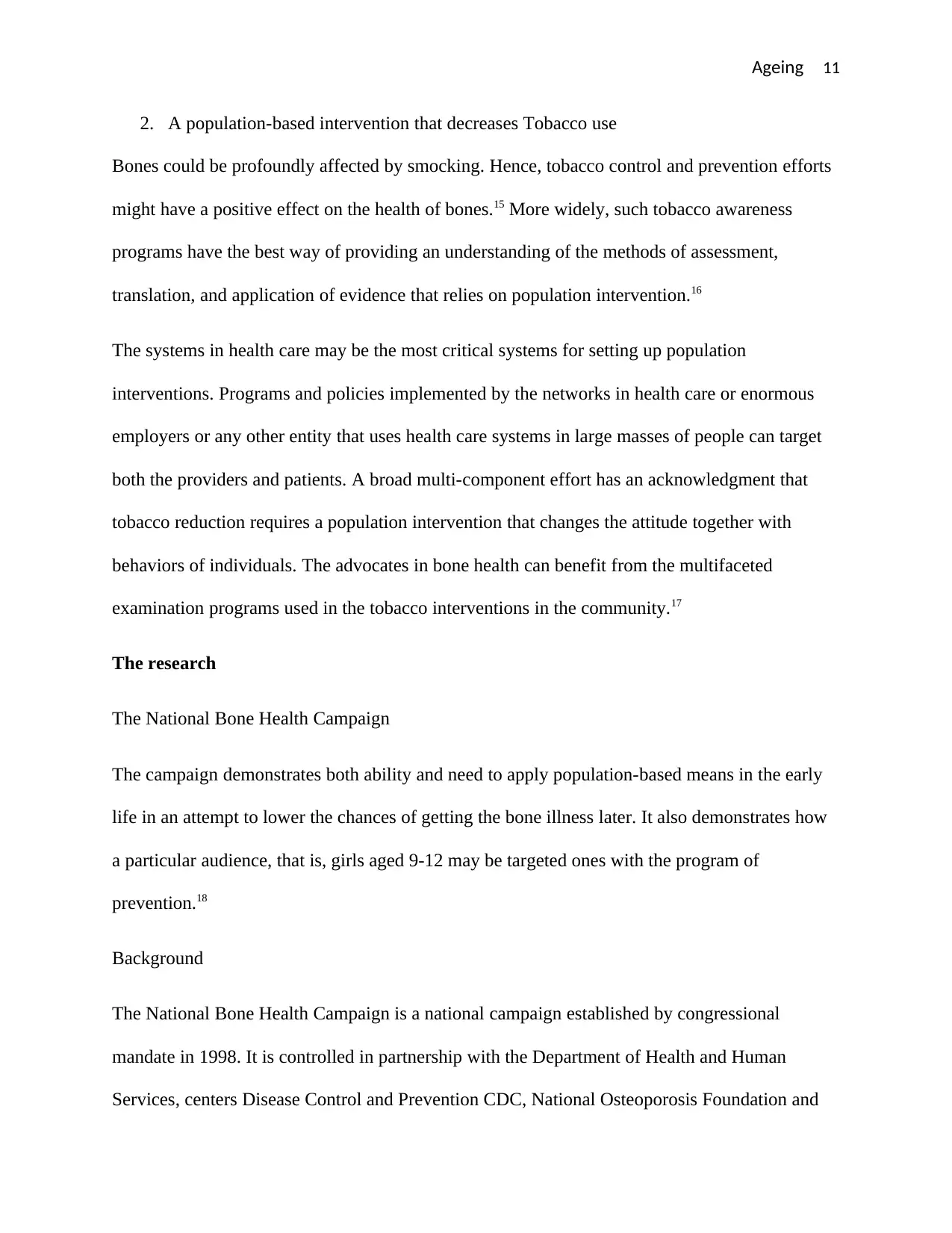
Ageing 11
2. A population-based intervention that decreases Tobacco use
Bones could be profoundly affected by smocking. Hence, tobacco control and prevention efforts
might have a positive effect on the health of bones.15 More widely, such tobacco awareness
programs have the best way of providing an understanding of the methods of assessment,
translation, and application of evidence that relies on population intervention.16
The systems in health care may be the most critical systems for setting up population
interventions. Programs and policies implemented by the networks in health care or enormous
employers or any other entity that uses health care systems in large masses of people can target
both the providers and patients. A broad multi-component effort has an acknowledgment that
tobacco reduction requires a population intervention that changes the attitude together with
behaviors of individuals. The advocates in bone health can benefit from the multifaceted
examination programs used in the tobacco interventions in the community.17
The research
The National Bone Health Campaign
The campaign demonstrates both ability and need to apply population-based means in the early
life in an attempt to lower the chances of getting the bone illness later. It also demonstrates how
a particular audience, that is, girls aged 9-12 may be targeted ones with the program of
prevention.18
Background
The National Bone Health Campaign is a national campaign established by congressional
mandate in 1998. It is controlled in partnership with the Department of Health and Human
Services, centers Disease Control and Prevention CDC, National Osteoporosis Foundation and
2. A population-based intervention that decreases Tobacco use
Bones could be profoundly affected by smocking. Hence, tobacco control and prevention efforts
might have a positive effect on the health of bones.15 More widely, such tobacco awareness
programs have the best way of providing an understanding of the methods of assessment,
translation, and application of evidence that relies on population intervention.16
The systems in health care may be the most critical systems for setting up population
interventions. Programs and policies implemented by the networks in health care or enormous
employers or any other entity that uses health care systems in large masses of people can target
both the providers and patients. A broad multi-component effort has an acknowledgment that
tobacco reduction requires a population intervention that changes the attitude together with
behaviors of individuals. The advocates in bone health can benefit from the multifaceted
examination programs used in the tobacco interventions in the community.17
The research
The National Bone Health Campaign
The campaign demonstrates both ability and need to apply population-based means in the early
life in an attempt to lower the chances of getting the bone illness later. It also demonstrates how
a particular audience, that is, girls aged 9-12 may be targeted ones with the program of
prevention.18
Background
The National Bone Health Campaign is a national campaign established by congressional
mandate in 1998. It is controlled in partnership with the Department of Health and Human
Services, centers Disease Control and Prevention CDC, National Osteoporosis Foundation and
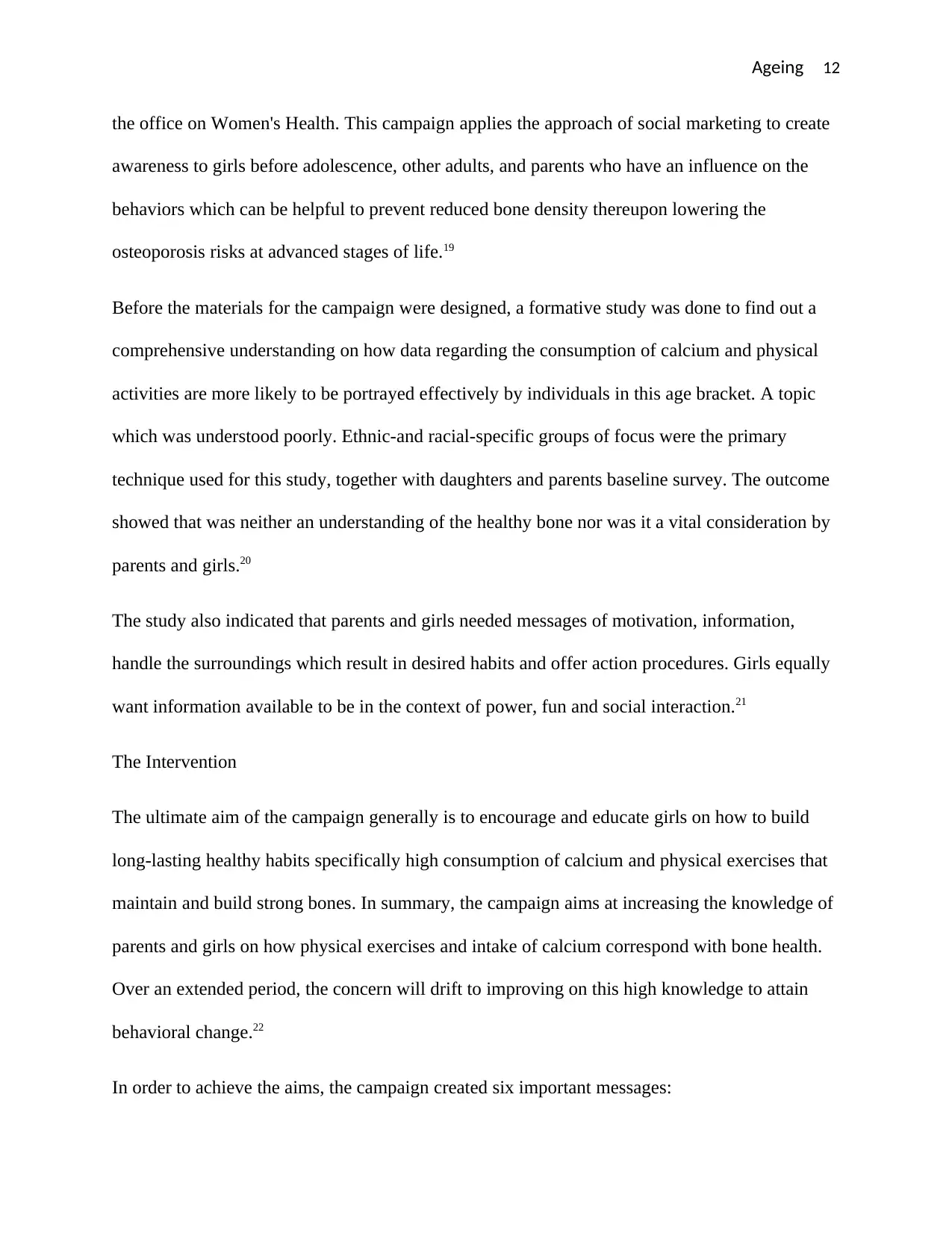
Ageing 12
the office on Women's Health. This campaign applies the approach of social marketing to create
awareness to girls before adolescence, other adults, and parents who have an influence on the
behaviors which can be helpful to prevent reduced bone density thereupon lowering the
osteoporosis risks at advanced stages of life.19
Before the materials for the campaign were designed, a formative study was done to find out a
comprehensive understanding on how data regarding the consumption of calcium and physical
activities are more likely to be portrayed effectively by individuals in this age bracket. A topic
which was understood poorly. Ethnic-and racial-specific groups of focus were the primary
technique used for this study, together with daughters and parents baseline survey. The outcome
showed that was neither an understanding of the healthy bone nor was it a vital consideration by
parents and girls.20
The study also indicated that parents and girls needed messages of motivation, information,
handle the surroundings which result in desired habits and offer action procedures. Girls equally
want information available to be in the context of power, fun and social interaction.21
The Intervention
The ultimate aim of the campaign generally is to encourage and educate girls on how to build
long-lasting healthy habits specifically high consumption of calcium and physical exercises that
maintain and build strong bones. In summary, the campaign aims at increasing the knowledge of
parents and girls on how physical exercises and intake of calcium correspond with bone health.
Over an extended period, the concern will drift to improving on this high knowledge to attain
behavioral change.22
In order to achieve the aims, the campaign created six important messages:
the office on Women's Health. This campaign applies the approach of social marketing to create
awareness to girls before adolescence, other adults, and parents who have an influence on the
behaviors which can be helpful to prevent reduced bone density thereupon lowering the
osteoporosis risks at advanced stages of life.19
Before the materials for the campaign were designed, a formative study was done to find out a
comprehensive understanding on how data regarding the consumption of calcium and physical
activities are more likely to be portrayed effectively by individuals in this age bracket. A topic
which was understood poorly. Ethnic-and racial-specific groups of focus were the primary
technique used for this study, together with daughters and parents baseline survey. The outcome
showed that was neither an understanding of the healthy bone nor was it a vital consideration by
parents and girls.20
The study also indicated that parents and girls needed messages of motivation, information,
handle the surroundings which result in desired habits and offer action procedures. Girls equally
want information available to be in the context of power, fun and social interaction.21
The Intervention
The ultimate aim of the campaign generally is to encourage and educate girls on how to build
long-lasting healthy habits specifically high consumption of calcium and physical exercises that
maintain and build strong bones. In summary, the campaign aims at increasing the knowledge of
parents and girls on how physical exercises and intake of calcium correspond with bone health.
Over an extended period, the concern will drift to improving on this high knowledge to attain
behavioral change.22
In order to achieve the aims, the campaign created six important messages:
⊘ This is a preview!⊘
Do you want full access?
Subscribe today to unlock all pages.

Trusted by 1+ million students worldwide
1 out of 20
Related Documents
Your All-in-One AI-Powered Toolkit for Academic Success.
+13062052269
info@desklib.com
Available 24*7 on WhatsApp / Email
![[object Object]](/_next/static/media/star-bottom.7253800d.svg)
Unlock your academic potential
Copyright © 2020–2025 A2Z Services. All Rights Reserved. Developed and managed by ZUCOL.





